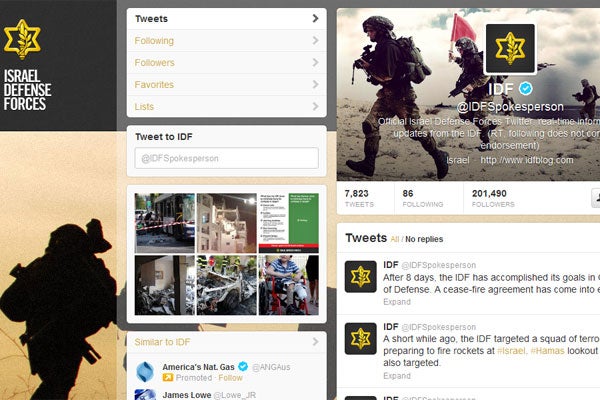Israel has been live blogging on its attacks as well as major strikes upon it by Hamas during the most recent crisis. Israel and Hamas have been active on social media sites such as Twitter, indicating the importance both sides see in the public relations element of this conflict. While both sides continue to exploit this powerful new medium, the U.S. can learn how to better win its own social media battles.
The Israeli campaign, known as “Pillar of Defense,” used a public relations plan that was designed to be a social media-led operation. The Israel Defense Forces (IDF) even announced the campaign via a tweet as opposed to the normal press conference:
The IDF has begun a widespread campaign on terror sites & operatives in the #Gaza Strip, chief among them #Hamas & Islamic Jihad targets.
— IDF (@IDFSpokesperson) November 14, 2012
As The Washington Post aptly put it, “the [Twitter] account @IDFSpokesperson has kept up a day-long stream of ultra-shareable posts, with more videos, graphics and calls for retweet than a social media best-practice class.”
Sadly for Israel, some reports indicate that key metrics for social media success seem to favor Hamas’ more basic approach. The Hamas Twitter tag #GazaUnderAttack and certain derivations had received 150 times more Twitter mentions than the IDF’s #PillarofDefense as of a week ago, although analyzing such Twitter tags is difficult considering all the different variants in spelling, languages, and related tags.
While it may be losing the mass messaging war, other indicators show that Israel’s well-prepared social media campaign may have won other crucial victories. Most critically, its forthright and aggressive public relations approach may have helped gain the support of world leaders, especially in Europe, who have often been critical of Israeli military operations in the past.
Information warfare and the battle for the support of others have existed for as long as humans have spoken and written. Heritage expert James Carafano argues in his book Wiki at War that just as hills and fortified heights are critical in traditional war, there are also important high grounds to capture in the social media battleground. The first hill to capture is the realm of mass messaging or broadcasting, i.e., how many people do your social media efforts reach? Based on the metrics available to us, Hamas seems to be controlling this high ground, though Israel is fighting hard to reduce the margin.
The second important social media hill to control is the area of small groups of informed decision makers having meaningful dialogue. In this arena, it is not so much who does more, but who acts first. Israel has seized this hill by acting quickly, and this seems to have helped consolidate the support of European leaders.
There are several lessons the U.S. can learn from this. First is that the fanciest Twitter campaign in the world does not guarantee victory in broadcasting. To be victorious here, nations must engage with their citizens and others who are known broadcasters with lots of contacts. Second, acting and reacting quickly can allow a nation to outperform its adversaries, reaching and connecting with decision makers and other small, influential groups.
The social media battle between Israel and Gaza is neither the start nor the end of the ongoing public relations war, and we should expect to see increasingly savvy attempts to seize the social media high ground.
